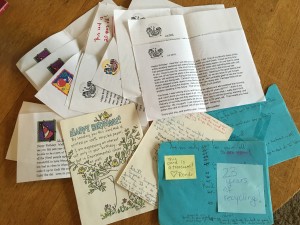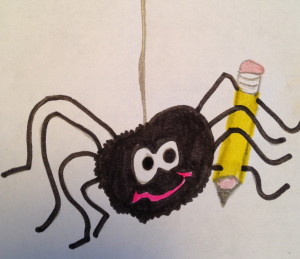By Rondi Sokoloff Frieder
 I did some serious preparation before pounding out the first draft of my current MG novel. After thinking about the story for years, I came up with a plausible beginning, a somewhat-hazy-but-action-packed middle, and what I thought could be a satisfying ending. I did rough character sketches and gave each person a name, a family, and a physical appearance. I visualized the various settings. Then I typed out a detailed five-page chapter outline. But when the actual writing began, things changed. A lot. You know how it goes. My characters came to life and did what characters do. They went on unexpected adventures and made unanticipated decisions. They directed the action and their personalities and passions bubbled up and morphed along the way. I thought I knew these kids before I wrote the story. But they’re different now. Their voices and desires have evolved. Some names have even been changed. So before I begin revision #1, I’m sitting down to interview each one of them again to make sure I know exactly who they are.
I did some serious preparation before pounding out the first draft of my current MG novel. After thinking about the story for years, I came up with a plausible beginning, a somewhat-hazy-but-action-packed middle, and what I thought could be a satisfying ending. I did rough character sketches and gave each person a name, a family, and a physical appearance. I visualized the various settings. Then I typed out a detailed five-page chapter outline. But when the actual writing began, things changed. A lot. You know how it goes. My characters came to life and did what characters do. They went on unexpected adventures and made unanticipated decisions. They directed the action and their personalities and passions bubbled up and morphed along the way. I thought I knew these kids before I wrote the story. But they’re different now. Their voices and desires have evolved. Some names have even been changed. So before I begin revision #1, I’m sitting down to interview each one of them again to make sure I know exactly who they are.
I like using the character inventory from Debbie Dadey and Marcia Thornton Jones’s book, STORY STARTERS, but have modified it over the years. This is the interview form I use today. I open my computer, visualize my character sitting across from me, say hello, and ask away:
What is your:
- Full Name:
- Nickname(s) Who calls you these nicknames and why:
- Age and grade in school:
- Birthday:
- Name of school:
- Hair color:
- Eye color:
- One distinguishing physical feature you like about yourself and one you don’t like at all!
- Who do you resemble in you family? Appearance, personality?
- A physical habit you have:
- One speech mannerism that makes you sound like you:
- Hobbies:
- Family members:
- Earliest childhood memory:
- One distinguishing personality feature that you love about yourself and one you don’t:
- Pets you have and pets you want:
- Thing of which you are most proud:
- Thing you hope nobody will ever find out:
- Strengths:
- Weaknesses:
- Fears:
- More than anything, the one thing you want is:
- The perfect way you might spend a summer day:
- The perfect way you might spend a winter day:
- Favorite sports to play, watch, or attend:
- Favorite musicians:
- Type of music you listen to:
- Games you like to play:
- Favorite foods and snacks:
- Clothes you love to wear:
- Clothes you hate wearing:
- The best part of school:
- The worst part of school:
- Best friend(s):
- The one thing worth fighting about with your friend?
- Prized possessions:
- Best birthday party:
- Favorite holiday and why:
- Where do you live? Describe in detail.
- What does your room look like?
- Favorite place to spend time alone:
- What new relationships do you develop in this book?
- How do you change and grow in this story?
- What part of what you want do you get in this story?
- What new thing(s) happens to you that you didn’t expect in this book?
This form is also great to fill out before you “Scrapbook Your Novel.” Our very own Carrie Seidel has written a blog about how to do this. Check out her post from October 2015 or read her article in the SCBWI newsletter Spring/2016. Then Google, cut, and paste.
You’ll be surprised at how these new details will add depth to your story and get your readers to deeply connect with your characters. For example, after I realized how important astrology was to my main character Cori, I assigned birthdays to two of her close friends based on compatible signs! What other items would YOU add to this personality inventory? Let me know and I’ll add it to the list. Write-on!



